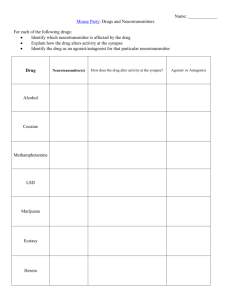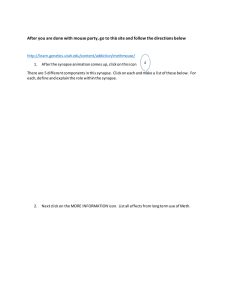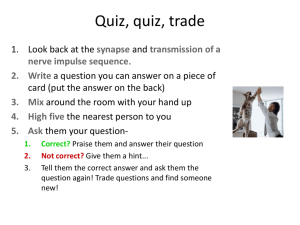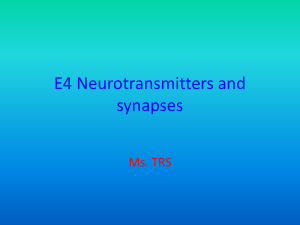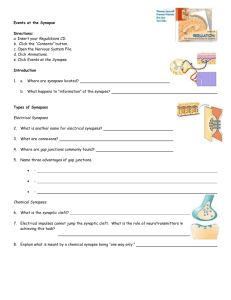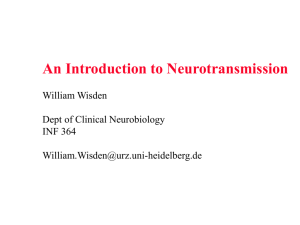E4: Neurotransmitters & Synapses
advertisement
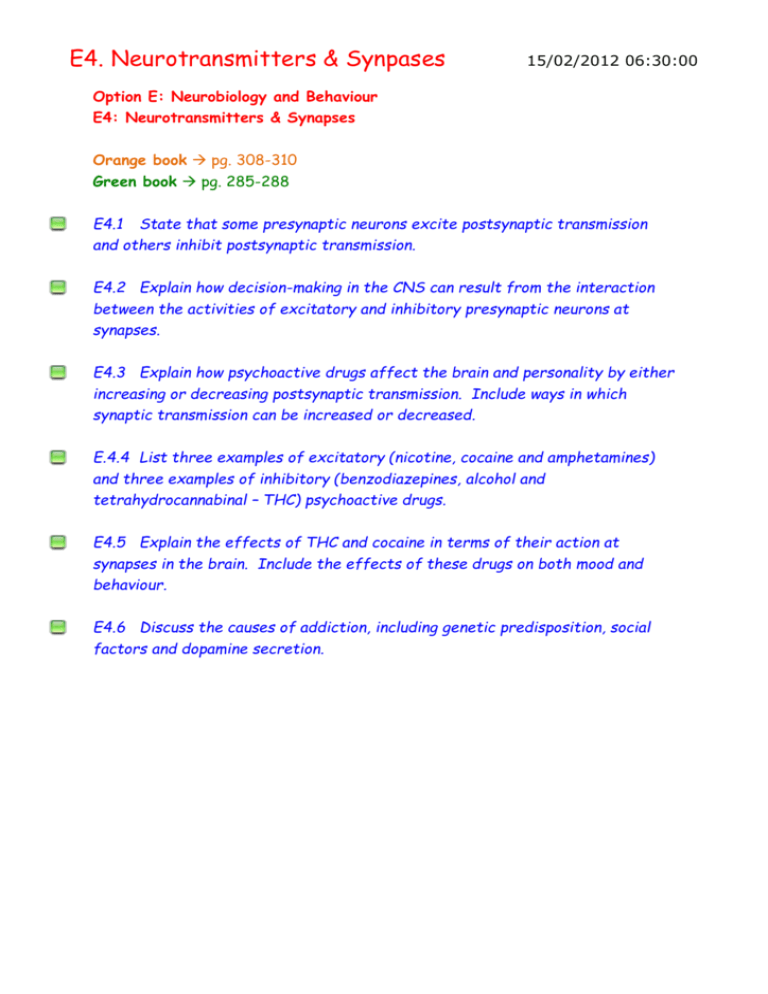
E4. Neurotransmitters & Synpases 15/02/2012 06:30:00 Option E: Neurobiology and Behaviour E4: Neurotransmitters & Synapses Orange book pg. 308-310 Green book pg. 285-288 E4.1 State that some presynaptic neurons excite postsynaptic transmission and others inhibit postsynaptic transmission. E4.2 Explain how decision-making in the CNS can result from the interaction between the activities of excitatory and inhibitory presynaptic neurons at synapses. E4.3 Explain how psychoactive drugs affect the brain and personality by either increasing or decreasing postsynaptic transmission. Include ways in which synaptic transmission can be increased or decreased. E.4.4 List three examples of excitatory (nicotine, cocaine and amphetamines) and three examples of inhibitory (benzodiazepines, alcohol and tetrahydrocannabinal – THC) psychoactive drugs. E4.5 Explain the effects of THC and cocaine in terms of their action at synapses in the brain. Include the effects of these drugs on both mood and behaviour. E4.6 Discuss the causes of addiction, including genetic predisposition, social factors and dopamine secretion. E4.1 Excitation & Inhibition 15/02/2012 06:30:00 E4.1 State that some presynaptic neurons excite postsynaptic transmission and others inhibit postsynaptic transmission. Orange book pg. 308 Green book pg. 285 To do: Watch the Youtube clip “Neurone Synapse” http://www.youtube.com/watch?v=LT3VKAr4roo (easier & quicker to watch from saved download in the E4 folder) Read the first paragraph below “Synapses”. Use the Youtube Clip and the paragraph you have just read to draw a basic annotated diagram of a synapse. Synapses You may remember that neurons communicate with each other chemically across a space called a synapse. On one side of the synapse is the presynaptic membrane of the sending neurone and on the other side of the synapse is the postsynaptic membrane of the receiving neurone. The molecules which move across the space (synaptic cleft) between the two membranes is called a neurotransmitter. At the postsynaptic membrane, there is a receptor molecule. A specific neurotransmitter is received by a specific receptor. To do: Go through the following presentation: “Crossing the Divide: How neurons talk to each other” http://learn.genetics.utah.edu/content/addiction/reward/neurontalk.html Read the paragraphs below on “Excitation and Inhibition” In your books, write a very brief of explanation of how Excitatory and Inhibitory synapses work. Excitation & Inhibition Some neurtransmitters are excitatory and stimulate the next neurone to forward the message. The way they do this is to increase the permeability of the postsynaptic membrane to positive ions (Na+), making it easier for positive ions to move in. Some neurotransmitters are inhibitory. They cause positive ions (K+), to move out of the postsynaptic cell, at the same time negative (Cl-) move in. Movement of positive ions back in to the synaptic cleft chemically depresses the postsynaptic cell and makes it much harder to excite. E4.2 Decision Making 15/02/2012 06:30:00 E4.2 Explain how decision-making in the CNS can result from the interaction between the activities of excitatory and inhibitory presynaptic neurons at synapses. Orange book pg. 308 Green book pg. 286 To do: *You should recognize this section on Synapses. Read the paragraph below: “Interactions at the Synapse” In the form of a flow chart, state the events which occur at the synapse. Interactions at the synapse The impulse which moves down the presynaptic neurone is called the action potential. As the action potential reaches the synaptic knob, calcium ions (Ca2+) rush into the end of the neurone. This causes vesicles containing neurotransmitters to fuse with the presynaptic membrane. As the vesicles fuse with the presynaptic membrane they release the neurotransmitters into the synaptic cleft. The neurotransmitter binds to specific receptors on the postsynaptic membrane. The receptors are like gates, which let ions enter or leave when the neurotransmitter binds to them. To do: *You should recognize this section on Excitatory Neurotransmitters. View the animation: “Chemical Synapse” http://highered.mcgrawhill.com/sites/0072495855/student_view0/chapter14/animation__chemical_sy napse__quiz_1_.html Complete short quiz below the animation. Read the paragraphs below “Excitatory Neurotransmitters” In the form of a flow chart, state the events which occur at an acetylcholine synapse. Excitatory Neurotransmitters Acetylcholine is an example of a neurotransmitter, which is excitatory. An excitatory neurotransmitter generates an action potential. Excitatory neurotransmitters increase the permeability of the postsynaptic membrane to positive ions. This causes positive sodium ions (Na+) which are in the synaptic cleft to diffuse into the postsynaptic neurone. The postsynaptic neurone is depolarized locally (just in that area) by the influx of positive sodium ions. During depolarization, the inside of the neurone develops a net positive charge compared to the outside. Depolarisation is the way the impulse is carried along the neurone. The neurone is locally depolarized and the depolarization continues as sodium ions diffuse to the next area of the neurone. In this fashion, the impulse if conducted along the neurone from one adjacent area to the next, just like a wave. An action potential is formed as the membrane depolarization is raised above the threshold. This means that the impulse is being carried along the nerve. If the threshold is not met, the neurone does not carry the impulse to the next neurone. To do: Watch the Youtube clip: “Gaba Synapse” http://www.youtube.com/watch?v=-pfG6yHAQ5U (easier & quicker to watch from saved download in the E4 folder) Read the paragraphs below: “Inhibitory Neurotransmitters” In your books, in your own words, describe how GABA acts as an inhibitory neurotransmitter. Inhibitory neurotransmitters GABA is an example of an inhibitory neurotransmitter. These neurotransmitters inhibit action potentials. An inhibitory neurotransmitter causes hyperpolarization of the neurone (inside of the neurone becomes more negative) making it even more difficult for an action potential to be generated. The inhibitory neurotransmitter binds to specific receptor. This causes negatively charged chloride ions (Cl-) to move across the postsynaptic membrane into the postsynaptic cell or is can cause positively charged K+ ions to move out of the postsynaptic neurone. This movement of Cl- into the neurone or K+ out of the neurone is what causes hyperpolarisation. Putting it together To do: Go to the following website: http://hsc.uwe.ac.uk/synapses_neuro/summation.htm Go to the section on “Spatial Summation”. Change the synapses from inhibitory to excitatory to see the effect on the firing of an action potential. Read the paragraph below “Summation”. In your own words (in your books), describe the decision making that happens at a synapse with multiple inputs. Summation A neurone is on the receiving end of many excitatory and inhibitory stimuli. The neurone sums up the signals. If the sum of the signals is inhibitory then the axon does not fire. If the sum of the signals is excitatory then, the axon fires. This is the interaction that takes place between the activities of the excitatory and inhibitory neurons at the synapses. The summation of the messages is the way that decisions are made by the CNS. E4.3 Psychoactive Drugs 15/02/2012 06:30:00 E4.3 Explain how psychoactive drugs affect the brain and personality by either increasing or decreasing postsynaptic transmission. Include ways in which synaptic transmission can be increased or decreased. Orange book pg. 309 Green book pg. 286 To do: Watch it again – just because it is funny “Spiders on Drugs” http://www.youtube.com/watch?v=sHzdsFiBbFc Watch the animation: “Synaptic Transmission – Neuromuscular Junction” http://bcs.whfreeman.com/thelifewire/content/chp44/4403s.swf You already know this sequence of events. Focus on the end of the animation: 1. what is the effect of the release of acetylcholine on the post-synaptic neurone? 2. How is acetylcholine inactivated? Take the short quiz. Read the paragraphs below “Cholinergic synapses – acetylcholine” Answer the following questions in your books to act as summary notes: 1. What would happen in acetylcholine was not inactivated (broken down)? 2. Which part of the nervous system is acetylcholine associated with? 3. Describe the general “function” of this side of the nervous system. Psychoactive drugs affect the brain and personality To fully understand how drugs affect the brain and personality we must have an understanding of the two main neurotransmitters. They are called acetylcholine and noradrenaline. Cholinergic synapses - acetylcholine Acetylcholine is released by all motor neurons and activates skeletal muscle. It travels across the synapse and depolarizes the postsynaptic membrane. However, if it remained in the synapse, the postsynaptic membrane would go on firing indefinitely. To prevent this, an enzyme called acetylcholinesterase breaks down acetylcholine in the synapse. Acetylcholine is involved in the parasympathetic nervous system (more on that later). This means it causes relaxation rather than flight. Synapses using acetylcholine are called cholinergic synapses. Nictotine stimulates transmission in cholinergic synapses, which is why it has a calming effect on the body and personality. People addicted to nicotine become very agitated if they cannot have a cigarette. To do: Read the paragraph below: “Adrenergic Synapses – noradrenaline”. Answer the following questions, which will serve as your notes: 1. What are the similarities in the way in which actelycholine and noradrenaline work. 2. Which side of the nervous system is noradrenaline associated with. Adrenergic synapses - noradrenaline A second widespread neurotransmitter is noradrenaline. Noradrenaline depolarizes the postsynaptic neurone. Noradrenaline is involved in the sympathetic system (later). This means that it causes ‘fight or flight’ reaction. Synapses using noradrenaline are called adrenergic synapses. Cocaine and amphetamines stimulate adrenergic synapses. Cocaine and amphetamines both cause increased alertness, energy and euphoria. Table below compares cholinergic and adrenergic synapses. Cholinergic Adrenergic Neurotransmitter Acetylcholine (Ach) Noradrenaline System Parasympathetic Sympathetic Effect on mood Calming Increased energy, alertness and euphoria Drugs increasing Nicotine Cocaine and transmission at synapse amphetamines To do: View the animation: “The effects of drugs and diseases on synaptic transmission” http://outreach.mcb.harvard.edu/animations/synapse.swf Watch the animation for alcohol. What effect does alcohol have on the firing of post synaptic transmission? Watch the animation for nicotine. What effect does nicotine have on the firing of post synaptic transmission? Watch the animation for cocaine. What effect does cocaine have on the firing of post synaptic transmission? This second website explains the effects of many drugs on the brain: http://www.jellinek.nl/brain/index.html Focus on the effect of the drug at the synapse: Excitatory drugs: Nicotine Cocaine Speed (amphetamine) Inhibitory drugs: alcohol Cannabis (THC) Read the paragraph below “Effects of drugs on the brain”. Make a list in your books of the mechanisms by which drugs can act at the synapse. Effect of drugs on the brain Drugs can alter your mood or your emotional state. Excitatory drugs like nicotine, cocaine and amphetamines increase nerve transmission while inhibitory drugs such as benzodiazepines, alcohol and tetrahydrocannabinol (THC) decrease the likelihood of nerve transmission. Drugs act at the synapses of the brain by different mechanisms to determine your emotional state. Drugs can change synaptic transmission in the following ways: Block a receptor for a neurotransmitter (drug has structure similar to neurotransmitter) Block the release of a neurotransmitter from the presynaptic membrane Enhance release of a neurotransmitter Enhance neurotransmission by mimicking a neurotransmitter (when drugs have the same chemical structure as the neurotransmitter they have the same effect but are not broken down as easily so the effect is stronger because they stay longer in the synapse) Block the removal of a neurotransmitter from the synapse and prolong the effect of the neurotransmitter. E4.4 Drugs 15/02/2012 06:30:00 E.4.4 List three examples of excitatory (nicotine, cocaine and amphetamines) and three examples of inhibitory (benzodiazepines, alcohol and tetrahydrocannabinal – THC) psychoactive drugs. Orange book pg. 309 Green book pg. 286-287 Excitatory drugs: Nicotine Cocaine Amphetamine (e.g. speed) Inhibitory drugs: Benzodiazepine Alcohol Tetrahydrocannabinol (THC) (e.g. marijuana) E4.5 Effects of Drugs 15/02/2012 06:30:00 E4.5 Explain the effects of THC and cocaine in terms of their action at synapses in the brain. Include the effects of these drugs on both mood and behaviour. Orange book pg. 309 Green book pg. 286-387 To do: Go to the website: “Mouse Party” http://learn.genetics.utah.edu/content/addiction/drugs/mouse.html Drag the “marijuana mouse” to the chair Go through the animation once without taking any notes. Read the section below: “Tetrahydrocannabinol (THC)”. Now make some summary notes in your book. Drag the “cocaine mouse” to the chair. Go through the animation once without taking any notes. Read the section below: “Cocaine”. Now make some summary notes in your book. Tetrahydrocannabinol (THC) Found in marijuana Mimics neurotransmitter anandamide (role is not fully understood possible memory function ‘deletes’ information from memory we do not need)? THC binds to same receptor as anandamide THC is inhibitory causes post synaptic neurone to be hyperpolarized Marijuana disrupts short term memory in humans Cocaine Stimulates transmission at adrenergic synapses Causes release of dopamine and blocks removal of dopamine from synapse so it build up Over stimulation of postsynaptic neurone. This leads to the euphoria and alertness associated with cocaine Dopamine gives you a feeling of pleasure and is a molecule of the ‘reward pathway’ of the brain, hence the road to addiction. Extra Reading Marijuana users often describe the feelings produced as relaxing and mellow. Some say they feel lightheaded and hazy. The THC may dilate the pupils causing colour perception to become more intense. Other senses may be enhanced. Some experience a sense of panic and paranoia. At the synapse, THC acts on cannabinoid/ anandamide receptor. These receptors affect several mental and physical activities, including: Learning Coordination Problem solving Short-term memory Since THC mimics anandamide, it inhibits the neurons that anandamide inhibits but more than likely there is no enzyme for breaking down THC in the synapse. Its effect is much greater since it stays in the synapse longer. The hippocampus is important for short-term memory. When THC binds to these receptors, it interferes with short-term memory. THC also affects coordination, which is controlled by the cerebellum and the basal ganglia. This is another reason for motor impairment when using marijuana. Some of the effects of cocaine are euphoria, talkativeness and increase in mental alertness. There is a temporary decrease in the need for food and sleep. Large amounts of cocaine can cause erratic and violent behaviour. The synaptic effect of cocaine results from its ability to sustain the level of dopamine in the synapse. Since dopamine is the neurotransmitter in the ‘reward pathway’, the longer it stays in the synapse the better you feel. E4.6 Addiction 15/02/2012 06:30:00 E4.6 Discuss the causes of addiction, including genetic predisposition, social factors and dopamine secretion. Orange book pg. 310 Green book pg. 288 To do: Under headings listed, make brief bullet pointed notes on addiction: genetic predisposition social factors dopamine secretion Causes of addiction Many drugs can lead to addiction: alcohol, tobacco, psychoactive drugs and some pharmaceuticals. People take some drugs to alleviate symptoms of mental illness and other drugs just for pleasure. The body often develops a tolerance and needs more and more of the drug to produce the same result. Addiction is a chemical dependency on drugs where the drug has ‘rewired’ the brain and has become an essential biochemical in the body. Many people assume that smoking is just a bad habit. Scientific evidence shows that smoking has caused the brain to be ‘rewired’. Nicotine in tobacco products mimics acetylcholine. It is not broken down easily and causes release of dopamine in the ‘reward pathway’. People who smoke are craving a dopamine spike. Since the role of almost all commonly abused drugs is to stimulate the ‘reward pathway’ located in the brain, withdrawal of the drug produces symptoms which are the opposite of the euphoria. Common withdrawal symptoms are anxiety, depression and craving. In alcohol addiction, withdrawal symptoms include conditions which are sometimes fatal such as seizures and delirium tremens (sever shaking). Continued addiction is even more harmful. Inhaled drugs can damage lungs. When sharing needled, addicts risk contracting HIV as well as hepatitis B and C. Kidney disease is also common. Genetic predisposition The evidence of genetic predisposition to addiction is found in the studies of twins. Identical twins share the same genetic makeup. Studies of male twins find that when one twin suffers an addiction to alcohol or drugs, the rate of addiction in the second twin is 50% greater among identical twins than among non-identical twins. Other experiments indicate that a genetically determined deficiency of dopamine receptors predisposes certain people to addiction. In one study, scientists compared genetically manipulated alcohol-preferring rats to normal rats. The alcohol-preferring rats had 20% lower levels of dopamine receptors than non-preferring rats. The alcohol-preferring rats consumed 5 grams of ethanol per kilogram when given a choice between ethanol and water. The non-preferring rats consumed less than 1 gram of ethanol per kilogram of body weight. This study gives some support to the idea of a genetic predisposition to addiction. Social factors Societal factors can determine a child’s vulnerability to substance abuse. Such factors include family addiction, family parenting skills and mental health problems of family or child. Behaviour is often tied to the peer group. Peer pressure is very influential over adolescents and less so over adults. Adolescents can be influenced or coerced into experimentation with drugs by the peer group. Users teach new users what effects to expect and wheat altered state is desirable. This social learning occurs in all types of drug use. When a drug is introduced into a culture, it can become a problem that did not previously exist. When the British introduced opium to China, it quickly became a major social problem. Heroin, introduced into the US, has become a social catastrophe. The presence of alcohol at many social gatherings fosters the paradigm that alcohol must be available to have a party. In Saudi Arabia, where alcohol use is prohibited by the culture and the law, alcoholism is rare. Some research has shown that if drugs are cheap and easy to get hold of, addiction is more likely. Dopamine secretion Dopamine is the neurotransmitter which activates the ‘reward pathway’ and gives us a sense of pleasure or satisfaction. During cocaine use, dopamine builds up in the synapse. In drug addiction, dopamine receptors are constantly stimulated. Overstimulation decreases the number of receptors and the remaining receptors become less sensitive to dopamine. This process is called desensitization or tolerance. With tolerance, exposure to the drug causes less response than it previously caused. More and more of the drug is needed to have even the normal sense of well-being. This neuroadaptive change is probably critical for producing addiction. Recently, scientists studying knockout mice (genetically manipulated mice addicted to cocaine), have found another neurotransmitter which might be as important or more important than dopamine – glutamate. Glutamate may ‘oversee’ the learning and memories which lead to cocaine-seeking. Further experiments will shed more light on this.
